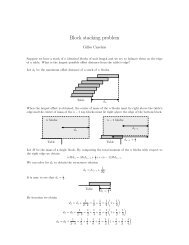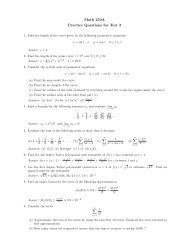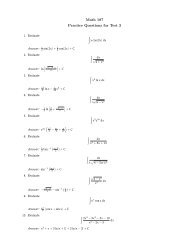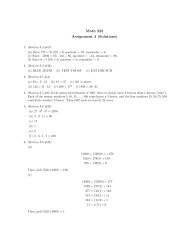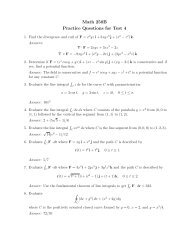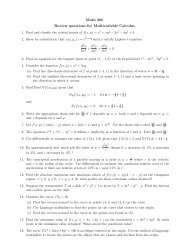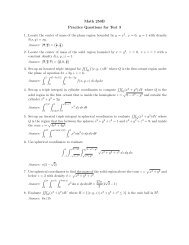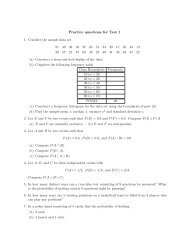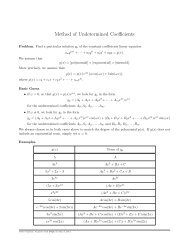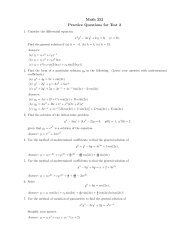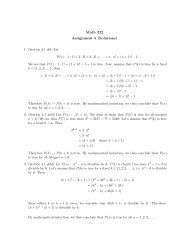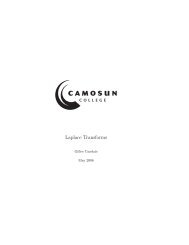Math 254 Assignment 4 (2011)
Math 254 Assignment 4 (2011)
Math 254 Assignment 4 (2011)
Create successful ePaper yourself
Turn your PDF publications into a flip-book with our unique Google optimized e-Paper software.
<strong>Math</strong> <strong>254</strong><br />
<strong>Assignment</strong> 4 (<strong>2011</strong>)<br />
1. High airline occupancy rates on scheduled flights are essential to corporate profitability. Suppose<br />
a scheduled flight must average at least 60% occupancy in order to be profitable, and an<br />
examination of the occupancy rate for 120 10:00 A.M flights from Toronto to Calgary showed a<br />
mean occupancy per flight of 58% and a standard deviation of 11%.<br />
(a) If µ is the mean occupancy per flight and if the company wishes to determine whether or<br />
not this scheduled flight is unprofitable, give the alternative and the null hypotheses for<br />
the test.<br />
(b) Does the alternative hypothesis in part (a) imply a one or two-tailed test? Explain.<br />
(c) Do the occupancy data for the 120 flights suggest that this scheduled flight is unprofitable?<br />
Test using α = .05.<br />
2. “Welcome to the new movie pre-show!” Before you can see the newly released movie you<br />
have just paid to see, you must sit through a variety of trivia slides, snack bar ads, paid<br />
product advertising, and movie trailers. Although the total barrage of advertising may last<br />
up to 20 minutes or more, a particular theatre chain claim that the average length of any<br />
one advertisement is no more than 3 minutes. To test this claim, 50 theatre advertisements<br />
were randomly selected and found to have an average of 3 minutes 15 seconds with a standard<br />
deviation of 30 seconds. Do the data provide sufficient evidence to indicate that the average<br />
duration of theatre ads is more than claimed by the theatre? Test at the 1% level of significance.<br />
3. Analyses of drinking water samples for 100 homes in each of two different sections of a city<br />
gave the following means and standard deviations of lead levels (in part per million):<br />
Section 1 Section 2<br />
Sample size 100 100<br />
Mean 34.1 36.0<br />
Standard deviation 5.9 6.0<br />
(a) Calculate the test statistic and its p-value (observed significance level) to test for a difference<br />
in the two population means. Use the p-value to evaluate the statistical significance<br />
of the results at the 5% level.<br />
(b) Use a 95% confidence interval to estimate the difference in the mean lead levels for the<br />
two sections of the city.<br />
(c) Suppose the city environment engineers will be concerned only if they detect a difference<br />
of more than 5 parts per million in the two sections of the city. Based on your confidence<br />
interval in part (b), is the statistical significance in part (a) of practical significance to the<br />
city engineers?<br />
4. A random sample of n = 1400 observations from a binomial population produced x = 529.<br />
(a) If your research hypothesis is that p differs from 0.4, what hypotheses should you test?<br />
(b) Calculate the test statistic and its p-value.<br />
(c) Do the data provide sufficient evidence to indicate that p is different from 0.4?<br />
5. Independent random samples of n 1 = 140 and n 2 = 130 observations were randomly selected<br />
from binomial populations 1 and 2, respectively. Sample 1 had 74 successes and sample 2 had<br />
72 successes.
<strong>Math</strong> <strong>254</strong> <strong>Assignment</strong> 4 (<strong>2011</strong>) Page 2 of 2<br />
(a) Suppose you have no preconceived idea as to which parameter, p 1 or p 2 , is the larger,<br />
but you want to detect only a difference between the two parameters if one exists. What<br />
should you choose as the null and alternative hypotheses for a statistical test?<br />
(b) Calculate the standard error for the difference in the two sample proportions, (ˆp 1 − ˆp 2 ).<br />
Make sure to use the pooled estimate for the common value of p.<br />
(c) p-value approach: Find the p-value for the test. Test for a significant difference in the<br />
population proportions at the 1% significance level.<br />
(d) Critical value approach: Find the rejection region when α = 0.01. Do the data provide<br />
sufficient evidence to indicate a difference in the population proportions?<br />
6. The braking ability was compared for two 2005 automobile models. Random samples of 64<br />
automobiles were tested for each type. The recorded measurement was the distance (in meters)<br />
required to stop when the brakes were applied at 65 km/h. These are the computed means and<br />
variances:<br />
Model 1 Model 2<br />
x 1 = 36 x 2 = 33<br />
s 2 1 = 31 s2 2 = 27<br />
Do the data provide sufficient evidence to indicate a difference between the mean stopping<br />
distances for the two models?<br />
7. A soft-drink manufacturer claims that its 355 mL cans do not contain, on average, more than<br />
30 calories. A random sample of 16 cans of this soft drink, which were checked for calories,<br />
contained a mean of 31.8 calories with a standard deviation of 3 calories. Assume that the<br />
number of calories in 355 mL cans is normally distributed. Does the sample information<br />
support the alternative hypothesis that the manufacturer’s claim is false? Use a significance<br />
level of 5%.<br />
8. A random sample of 14 cans of Brand I soda produced a sample mean of 23 calories per can<br />
with a standard deviation of 3 calories. Another random sample of 16 cans of Brand II soda<br />
produced a sample mean of 25 calories per can with a standard deviation of 4 calories. At the<br />
1% significance level, can you conclude that there is a difference between the mean number of<br />
calories per can for these two brands? Assume that the calories per can of soda are normally<br />
distributed for the two brands and that the standard deviations for the two populations are<br />
equal.<br />
9. A random sample of 15 observations from a normal population produced the following data.<br />
119 107 104 115 93 104 116 97 101 105 91 104 103 98 109<br />
(a) Find a 95% confidence interval for the population mean µ.<br />
(b) Find a 95% confidence interval for the population standard deviation σ.<br />
10. The following table lists the observed frequency for a sample of 120 rolls of a die.<br />
Number 1 2 3 4 5 6<br />
Frequency 14 23 17 31 19 16<br />
Use a chi-square test at the 5% significance level to test if the die is fair?



